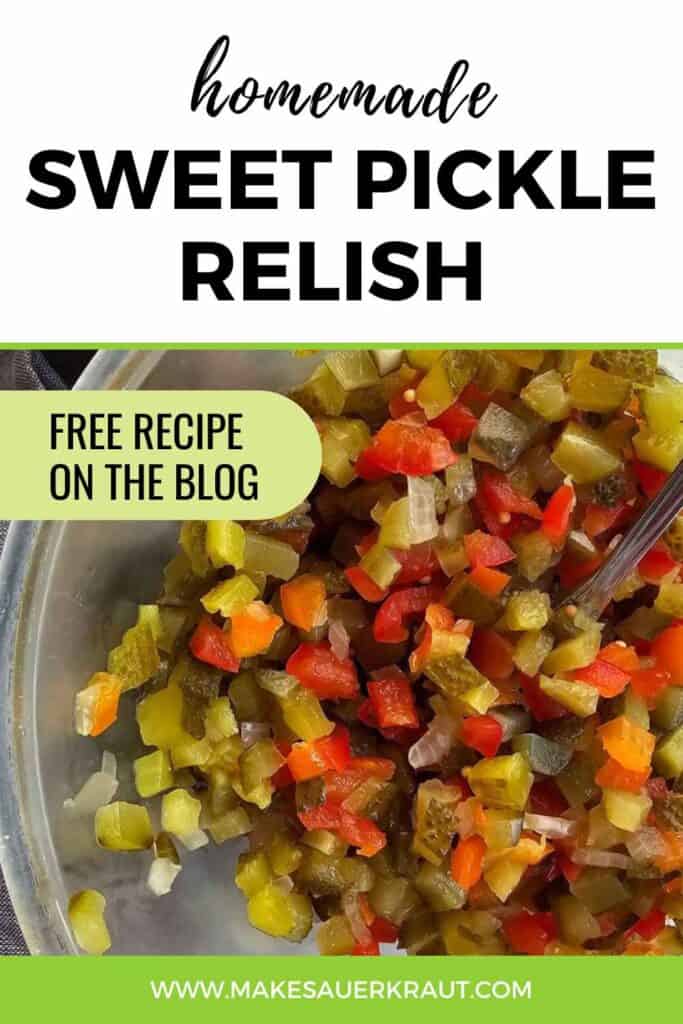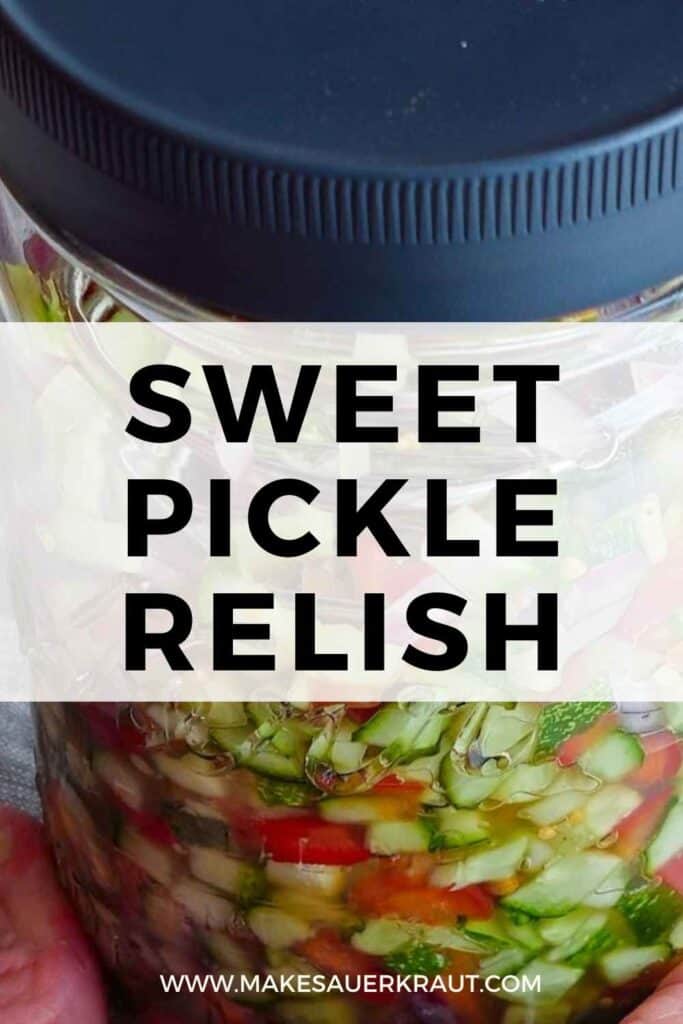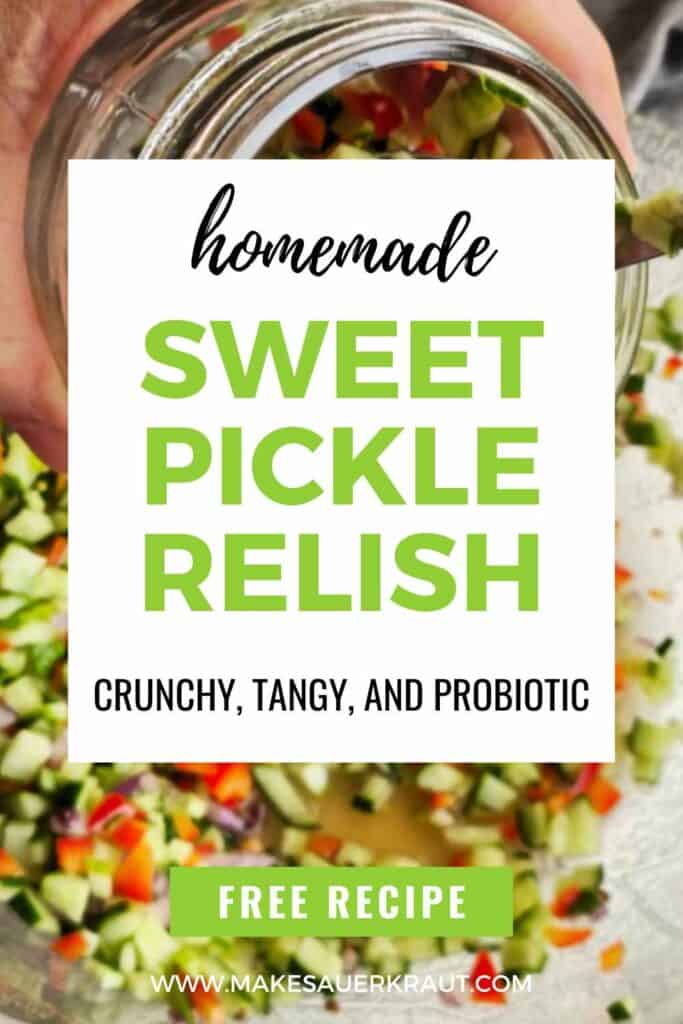Crafted from garden-fresh cucumbers, red pepper, and onion, our naturally fermented sweet pickle relish is the ideal topping for burgers, hot dogs, potato salad, or any dish you desire. What sets this relish apart is our unique fermentation technique—honey is introduced after the fermentation process, preserving its sweetness while creating a rich, probiotic-packed flavor. It’s an easy, foolproof way to venture into cucumber fermentation, free from harmful additives.
Reader Kerry commented: “We made this recipe because it looked like the healthiest sweet relish recipe. After fermenting and tasting it, we liked it so much ‘as is’ that we have not added the honey! It is the best pickle relish we have tasted. Thank you so much!” ★★★★★
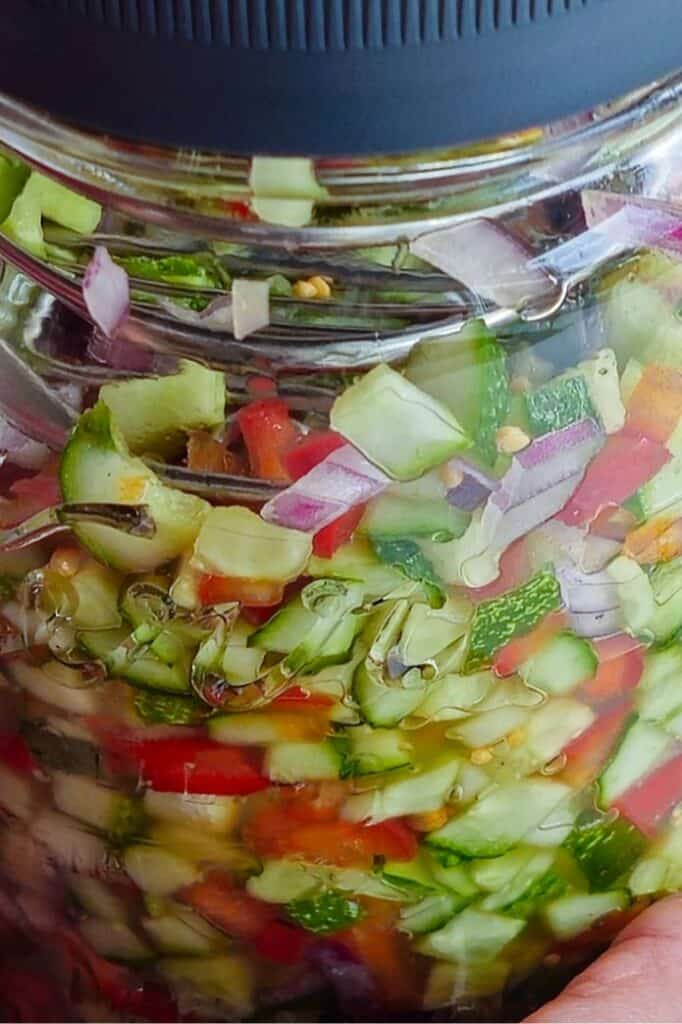
When cucumber season arrives, and you’ve already made your fair share of pickles, consider this recipe as a fantastic solution to make the most of your cucumber bounty.
This recipe offers simplicity and consistent outcomes, making it an excellent starting point for anyone new to cucumber fermentation.
A spoonful of the finished relish added to a hot dog or mixed into a pasta or potato salad recipe, not only adds a depth of flavor but contains enzymes and probiotics to help nourish your gut microbiome.
Why You’ll Love This Recipe
Pretty much, all storebought relish is pickled with hot vinegar and contains preservatives and nasty ingredients that you probably don’t want to consume.
I really wanted to have a sweet pickle relish without all the typical ingredients so I adapted the recipe for fermentation for a variety of reasons.
Fermented vegetables are naturally preserved. During fermentation, naturally occurring bacteria create lactic acid. This lactic acid acts as a safe and natural preservative, aids in digestion, and delivers a flavor-popping tang.
By making your own, you can control what goes in it and avoid nasty chemicals. No thank you to high fructose corn syrup, aluminum sulfate, polysorbate 80, artificial flavors, and artificial colors.
Check out this label for a popular brand of pickle relish:
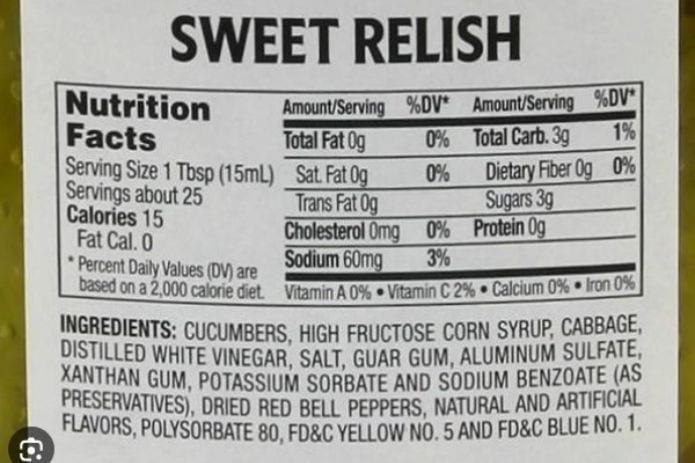
You control the final sweetness by adding honey at the end of fermentation. If we add sugar at the beginning of fermentation, we are just providing more food for the bacteria.
This not only makes for an over-active ferment but that sweetness is gone by the end of fermentation. The bacteria consume those sugars and make lactic acid. Adding it to taste at the end results in perfect, lip-smacking results.
You won’t find this relish to be overly salty. I love my brine-fermented vegetables, but they tend to be extra salty, especially pickles.
In this recipe, the prepared vegetables are fermented in their own brine much like sauerkraut. Instead of creating a brine with salt and added water (like most fermented vegetables), the brine is created when added salt pulls the water out of the cucumber cells.
This helps to cut down on the amount of salt used and results in a less salty finished product.
Not only is this relish deep in flavor, but it is rich in probiotics, deep in flavor. Naturally fermented foods contain prebiotics, probiotics, and enzymes that are important to consume on a regular basis to maintain a healthy gut. The more ways that we can effortlessly add fermented foods to our diet, the better our health.
Now, be pleasantly surprised at how easy it is to make your own relish.
Key Ingredients
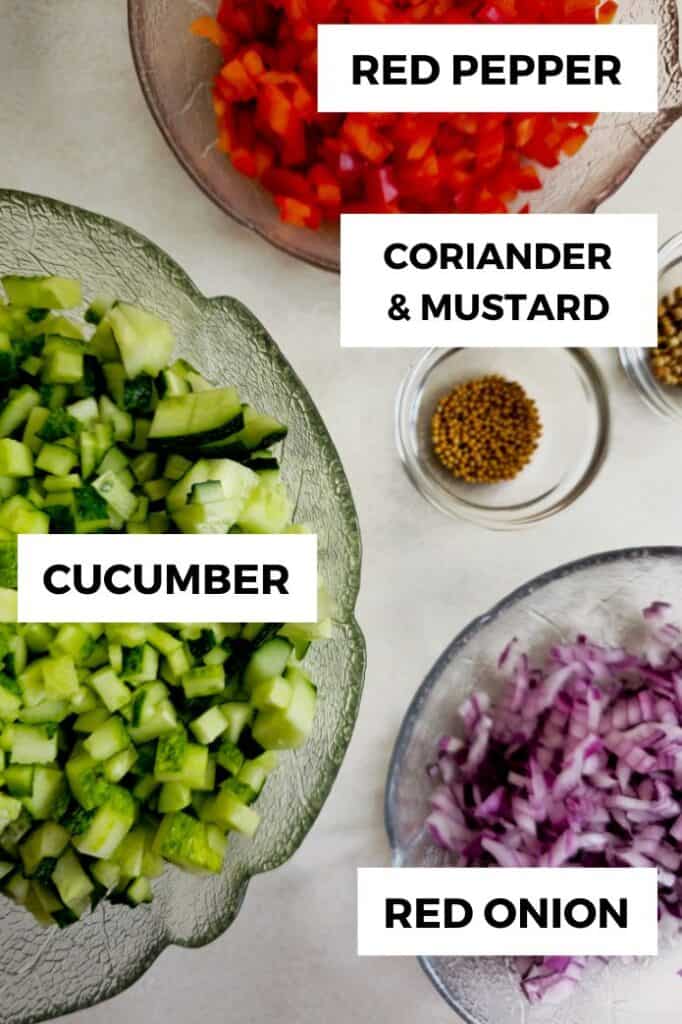
Local, fresh-picked vegetables always give you the best results. With fermentation, successful results depend upon the inherent bacteria naturally found on vegetables.
As you move past the pick date, the population of the bacteria that causes rot goes up and the number of the bacteria responsible for fermentation decreases. So, aim for as fresh as possible.
Typical ingredients in a pickle relish recipe are cucumbers, sweet pepper, and onion. I find that a ratio of about ½ cucumbers to ½ other ingredients works well.
Cucumbers. Ideally, use one of the best cucumbers for pickling such as Kirby, Persian, or English. I use a “snacking” cucumber picked small before seeds have formed or the skin has thickened. Since we dice the cucumbers and add other vegetables, this recipe is not as particular about what cucumber you use as it is when fermenting cucumber pickle spears.
Red pepper. A diced red pepper adds color and texture. If you want heat, add in some hot pepper.
Red onion. I like the color and flavor of red onion, but any variety of onion will work.
Spices. In this recipe, I used coriander and mustard seeds. Other options are celery seed, red pepper flakes (or my favorite, gochugaru—Korean red pepper—for a subtle heat), and turmeric.
Honey. Since, during the fermentation process, the bacteria consume the sugars in the ingredients, the “sweet” in this relish (honey) is added at the end of fermentation. I haven’t tried other sweeteners. I like that honey contains enzymes and bacteria that support the environment of a naturally fermented product.
Play around with the ingredients in this recipe and make it your own. Sweet corn would be a fun addition.
In Pictures: How to Make Sweet Pickle Relish
First, place your bowl on the scale. Either zero out your scale or write down the tare (weight) of your bowl. Then, chop your cucumbers, pepper, and onions. Add prepared ingredients to your bowl.
Determine how much salt to add by multiplying the total weight of ingredients by 0.03 for a 3% salt concentration. Add the correct amount of salt, mix well, and leave to sit for 1-2 hours during which time the salt will pull water out of your chopped vegetables to create a brine.
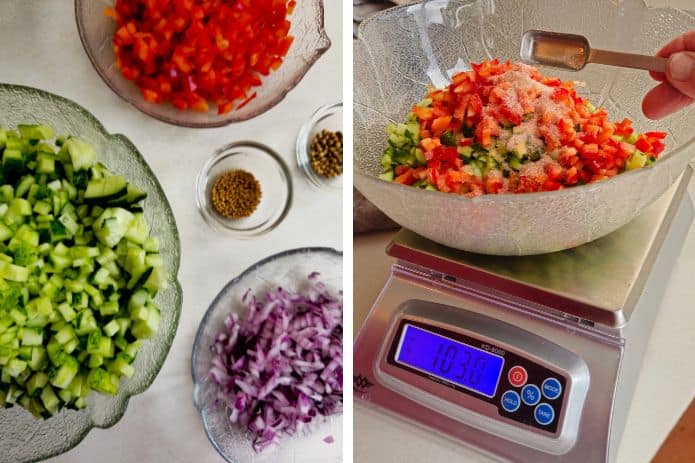
Pack the cucumber relish mixture into your jar leaving 1-2 inches of headspace. Seal the jar using a fermentation weight and airlock of your choosing.
Leave it to ferment on your counter and away from direct sunlight. Start tasting on day 5, stopping fermentation when the desired crunch and acidity are achieved.
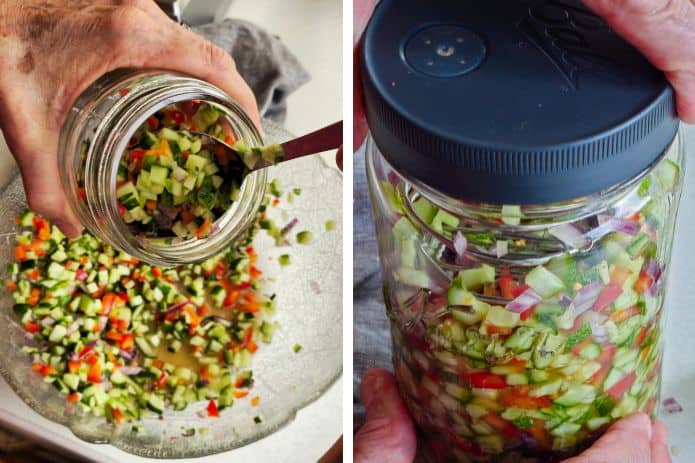
When fermented to your liking, remove the fermentation airlock and weight. Use a sieve to drain off the brine.
Place relish in a bowl and stir in a few tablespoons of honey, tasting as you go. I like just a hint of sweetness, others prefer more. Return to jar and stash in your fridge to enjoy and use at a moment’s notice.
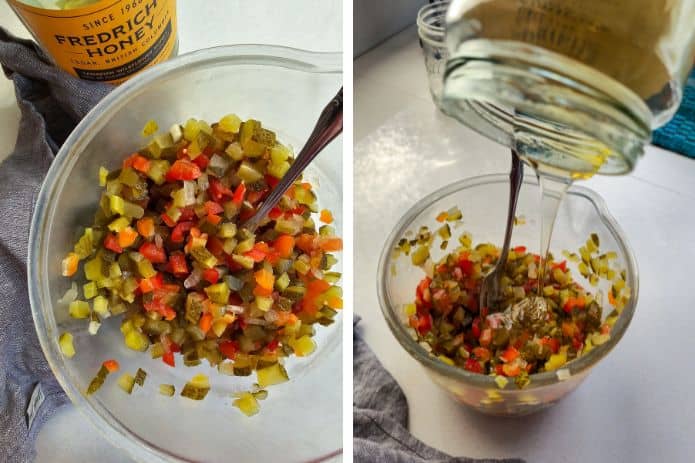
How to Serve & Use
Sweet pickle relish is a versatile condiment that can add a burst of flavor to a wide range of dishes. Here are some suggestions for how to serve and use sweet pickle relish:
Potato Salad or Coleslaw. Mix sweet pickle relish into your salad recipe for a delightful sweet and tangy twist. It adds depth of flavor and a pleasant crunch.
Deviled Eggs. Add a spoonful of sweet pickle relish to the filling of deviled eggs to create a slightly sweet filling.
Salad Dressing. Combe sweet pickle relish with olive oil, vinegar, mustard, and herbs.
Cheese and Charcuterie Board. Include sweet pickle relish as a condiment on cheese and charcuterie boards to balance the richness of the cheeses and cured meats.
Grilled Cheese. Add a spoonful of sweet pickle relish to your grilled cheese sandwich for a sweet and savory twist on this classic comfort food. Now, that sounds delish!
Feel free to get creative and experiment with sweet pickle relish in your favorite recipes. Its sweet and tangy flavor can enhance a wide variety of dishes.
Sweet Pickle Relish Recipe
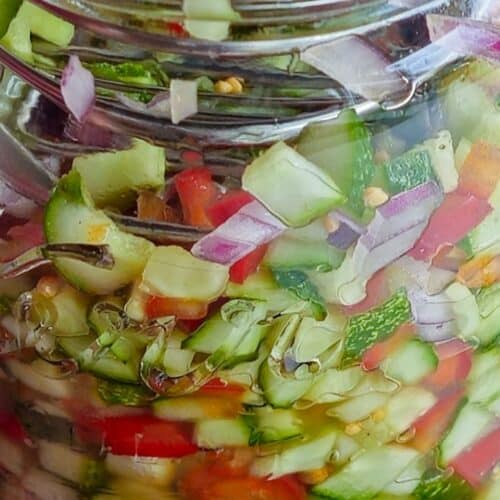
Sweet Pickle Relish Recipe
EQUIPMENT
- Digital scale
- 1 wide-mouth jar quart (liter)
- fermentation weight
- Airlock lid
- Large mixing bowl
- Food processor or chef’s knife
INGREDIENTS
- 1 pound pickling cucumbers, finely diced, 454g
- 1 sweet red pepper, finely diced, 100g
- 1/2 red onion, finely diced, 50g
- 1/2 tsp mustard seed, 2ml
- 1/2 tsp coriander seed, 2ml
- Salt (non-iodized), 3% of the total weight of ingredients
- 2-3 tbsp honey, ideally, raw
INSTRUCTIONS
- SET UP. Gather Supplies and Set Up ScalePlace your bowl on the scale. Either zero out your scale or write down the tare (weight) of your bowl.
- CHOP. Prep Your VegetablesPrep your cucumbers, red pepper, and red onion. Add to your bowl along with mustard and coriander seeds.
- SALT. Create Your BrineDetermine how much salt to add by multiplying the total weight of ingredients by 0.03 for a 3% salt concentration. For example, 600g ingredients x 0.03 = 18. Depending upon your scale, you may have to first subtract the weight of your bowl and ingredients from the weight of your bowl (tare). For example, weight of bowl + ingredients = 1674. Weight of bowl (tare) is 1074. 1674 – 1074 = 600. 600 is the number you’ll use to determine how much salt to add. Add the correct amount of salt, mix well, and leave to sit for 1-2 hours during which time the salt will pull water out of your chopped vegetables to create a brine.
- PACK. Pack Mixture into JarPack the cucumber relish mixture into your jar leaving 1-2 inches of headspace. Be sure to scrap any brine or leftover bits in the bowl into your jar. Press the mixture down to remove any air pockets.
- SUBMERGE. Hold Ferment Below BrineSeal the jar using a fermentation weight and airlock of your choosing. With the weight in place, you should see brine rise to the surface and cover your packed vegetables.
- FERMENT. Ferment for 1 to 2 WeeksLabel your jar with the recipe name and the day you started fermenting. Place your jar in a small bowl to catch any brine that may overflow and leave it to ferment on your counter away from direct sunlight. Monitor daily, pressing down any bits that rise to the surface. Start tasting on day 5, stopping fermentation when the desired crunch and acidity are achieved.
- SWEETEN. Drain and Add HoneyWhen fermented to your liking, remove the fermentation airlock and weight. Drain the relish. Be sure to save the brine. It can be used in salad dressings or sipped on for the beneficial probiotics, enzymes, and electrolytes. Place relish in a bowl and stir in a few tablespoons of honey, tasting as you go. I like just a hint of sweetness, others prefer more. Return to jar and store in your fridge, where it can keep for up to a year.
- ENJOY! ENJOY! ENJOY!Use this relish to make a condiment for hamburgers and hot dogs, add it to salads, or enjoy it spoonful all on its own. Delish!
Notes and Tips
- The number at the end of an ingredient item is the actual weight of the prepared ingredient and enables you to “Ferment by Numbers.“
- If there are large seeds in your cucumbers, remove them as they go slimy when fermented.
- If you want a smoother texture to your relish, feel free to chop the ingredients using a food processor being careful not to over-process.
- Adjust quantities and seasonings to your liking. The weights listed are what I used in a recent recipe. I’m still adjusting the weight of the cucumbers to fill the jar closer to the ideal ¾‘s full.
- No water or brine is added. Like with my sauerkraut recipes, the brine is created as the salt pulls the moisture out of the cucumbers.
- The crunch (or, softness) of the final product is determined by how finely you dice, how warm your kitchen is, and how long you ferment.
- This recipe is super adaptable. Use the quantities given as a guideline adjusting to what you like and what you have on hand. Keep notes!
Frequently Asked Questions
You can use store-bought cucumbers and other vegetables to make sweet pickle relish. I love to add sweet corn. Just make sure to choose fresh, high-quality vegetables to ensure not only the best flavor and texture in your relish but also the best fermentation results.
Use the correct amount of salt to create an environment that’s conducive to beneficial bacteria but inhospitable to pathogens.
During fermentation, monitor your relish for signs of success, such as bubbling, a tangy aroma, and the desired level of sourness. If there are unusual odors, mold, or other signs of spoilage, trust your gut and toss.
To make your relish sweeter, add more honey at the end of fermentation. To increase the spiciness, add hot peppers or chili flakes. You can also leave the seeds in the peppers for extra heat.
Fermented sweet pickle relish can typically be stored in the refrigerator for several months to a year. The exact duration may vary depending on factors like the acidity level, salt content, and how well the relish fermented.
Over time, the flavor of the relish may continue to develop, becoming tangier and more complex.
Happy Pickling!
Ready to embark on your sweet pickle relish adventure?
Share your experience with us in the comments below! We’d love to hear about your creative twists, flavor variations, and any questions you may have.


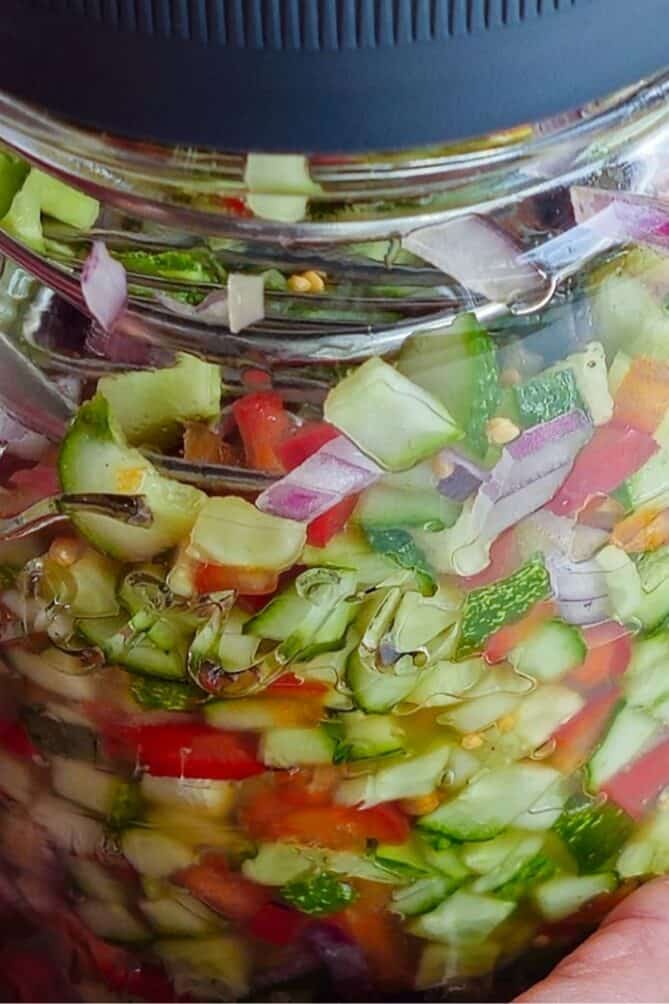

 This post may contain affiliate links which won’t change your price but will share some commission.
This post may contain affiliate links which won’t change your price but will share some commission.